There, I never thought I would write that as a headline. I hate motoring. It’s noisy and smelly. It’s expensive – also, it’s an admission of defeat. For the sailor to resort to the “iron topsail” just because the wind doesn’t agree to his plans is, somehow, a failure as great as not backing down the anchor or having the headsail fall over the side because you didn’t mouse the shackles on the furling gear.
But here I am, sitting on the port berth – normally, I would say the “leeward berth” but just at the moment there isn’t any leeward (or windward) for the very good reason that there isn’t any wind. But I’m not complaining. I am, indeed, unexpectedly happy with the situation.
I am in Cardigan Bay, on my way from Conwy, where Tony Jones of TJ Rigging replaced the forestay which broke at the end of the transatlantic crossing, to Falmouth where the Royal Cornwall Yacht Club is holding a reunion for the 50th anniversary of the Azores and Back Race. I competed in Largo in 1987 and again in 1991. I won a decanter. I’ve still got it somewhere…
But the Windy app says that if I sit here and wait for the predicted easterly, I will be waiting for a full 24 hours and miss the “before” party on Friday night.
So, when I awoke at 0700 to a blue sky through the central hatch and the sound of the mainsheet traveller shooting from side to side as the boat rolled in one of those calms so total that you can look over the side and see small and unlikely creatures skipping about on the surface, I had a decision to make.
Samsara carries 55 litres of fuel, and the tank was two-thirds full. The little Nanni 21hp sips about half a litre an hour at just under four knots. The wind is due to come back in 24 hours anyway. It’s no worse than buying a couple of rounds to go with the seafood linguine I ordered from the RCYC booking site.
To my surprise, I don’t mind at all. For a start, motoring makes the boat more stable – something to do with the flow of water over the keel, so this meant a proper breakfast.
Breakfasts are a bit of a thing at the moment, now that I’ve got a real pop-up toaster and enough Lithium to do one slice at a time and not worry about wasting the heat on the other side. This morning it was toast and the new vegan Marmite with smashed avocado, fried tomatoes and a Burford Brown egg – and then another slice of fresh hot toast to go with an enormous helping of Bonne Maman apricot jam.
Now add Colombian coffee (from Colombia) fresh-ground in the new 230volt coffee grinder!
See what I mean? By the time I rose from the saloon table, I’d forgotten we were motoring at all. Maybe the engine is quieter once it’s warmed up – maybe the problem is that I never let it run for long enough.
So then I replaced the length of Dyneema on the end of the topping lift with a soft shackle because the new line is the right length at last – whipped proper markers onto the main halyard in place of the pieces of tape. This was a hangover from having to end-for-end the halyard off the Grand Banks because it was about to chafe through where it passed over the sheave.
It was all going so frightfully well that I thought there might be a blog post in it, and came down to write this. The next thing you know it’s lunchtime and time for tea – which is when I noticed the batteries were back at 74%, where they had been before breakfast – not bad, given that the brilliant sun of early morning had given way to a high-pressure haze.
It was wondering about this that made me realise the wind charger had 12kts to play with – and since there was a one-and-a-half knot tide against us, that meant actually, we were going nowhere… which, in turn, meant that there really was 12kts of wind.
In which case, why wasn’t I sailing?
Well, I am now – doing a good three knots into the bay to get out of the tide. I should pick up a mobile signal, too.
And it went on like this for four days. I motored a bit to catch the tide off Land’s End – and then again to get out of it in Mount’s Bay. The Bristol Channel, as always when heading south, was wonderful with clear blue skies and a beam reach (which I should have used to put me up-tide at the end – see above).
In fact, it was all going swimmingly as I jogged past The Manacles and up to Black Rock, bang on schedule to walk through the town and arrive at the Royal Cornwall for a six o’clock drink with…
Well, that was the question, wasn’t it? Who would remember me from 1987? Who would I recognise? I turned the switch one last time to drop the main and come into the Haven Marina.
The engine stopped.
As if to say: “You think you can just use me when you feel like it – get a blog post out of a once-in-a-lifetime moment of appreciation, would you? Well, I know what you really think of engines…”
…and it was right. I said a very rude word. This was going to ruin everything. I would have to anchor off Trefusis Point – chase the blockage back from the injectors. I did think of leaving it ‘til the morning and blowing up the dinghy – but that would put me behind for packaging up the eBay parcels and getting to the Post Office before the opening event at 10.00 a.m – and there was coffee and mingling from 9.45.
I accepted that tonight it wasn’t going to be seafood linguine but a tin of beans – and no fresh vegetables because I wasn’t going to need them once I got here, was I?
So, I established that the main fuel filter was only half full – the pre-filter definitely needed changing – but there was nothing flowing from the breather when I slacked off the nut. We were back to Grenada and Nelson’s Dockyard, and https://www.oldmansailing.com/diesel/
I took the inlet pipe off the filter – nothing. So, the muck in the tank had blocked the outlet again. There is one way to clear that: Blow.
And so it was that with the taste of diesel still in my mouth, I let the engine run for a full 15 minutes while I cleared up, then puttered over to The Haven and rafted up alongside a French Halberg Rassey (always pick a French boat – you can give them a leaflet for the French translation of the book).
It was fully eight o’clock by the time I found three old AZAB competitors round a table on the RCYC’s Upper Deck. I didn’t recognise any of them.
But that’s the thing – they didn’t recognise me either. It’s been forty years. Now we’re just a bunch of old men.
But would you believe it: The 90-year-old who had left his walking stick on the table just where I was going to sit was Peter Phillips (Google: https://policesailing.uk/reports/ostar/ostar.htm)
There was Roy Hart, who went on to lead a sailing expedition to the North Pole – and blamed me for getting him into the 1988 OSTAR (I blamed him).
Brian Dale sailed the other Barracuda 35 – you’ll remember them if you remember the 1980s TV sailing soap opera Howard’s Way.
What a time we had with almost half a century of adventures to catch up on…
… and I had two puddings because I ordered a brandy and got a brownie. I’ve always wanted to order two puddings.

Four old men (L-R: Peter Phillips, self, Brian Dale, Roy Hart)


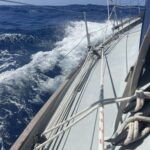
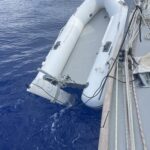
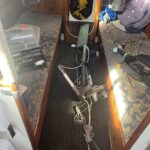
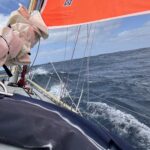
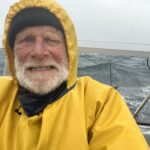

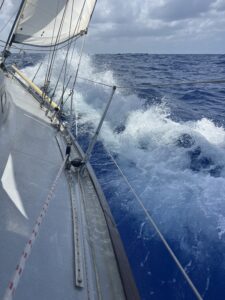


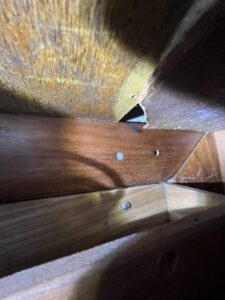


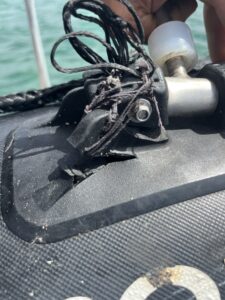








Nothing wrong with old men…..
So good meeting you last night at the celebrations John! I’m starting just now, a few weeks short of 60 yo, to realise my age old dream of sailing across the Oceans. Buying a Contessa 32, doing the AZAB27 and then the dream is to take her around the world in the wake of Sir Robin and Bernard Moitessier (here’s my project oneandocean.com)
Meet you somewhere sometime, take care!
Leonardo
Really sorry I didn’t recognise you either, otherwise I would have introduced myself (AZAB 2015, 2019 and OSTAR 2017)
Have missed your updates since you left Panama so good to hear from you again.
BZ John!
BZ is the US Coast Guard’s message abbreviation for great job! Keep up the good work, it’s good to hear that you’re still out there living the dream!
Glad to see you’re still at it! Hail fellows well met all ~ ✨
That must have been quite a re-union – so glad you made it in time and with just enough “events” to make for yet another very entertaining anecdote. Cheers John!
Just great…such a story where the ordinary everyday events we grapple with become our raison d’etre. And double pudding to boot…now that’s real living…what a great reunion!
Good luck John, so happy for you!